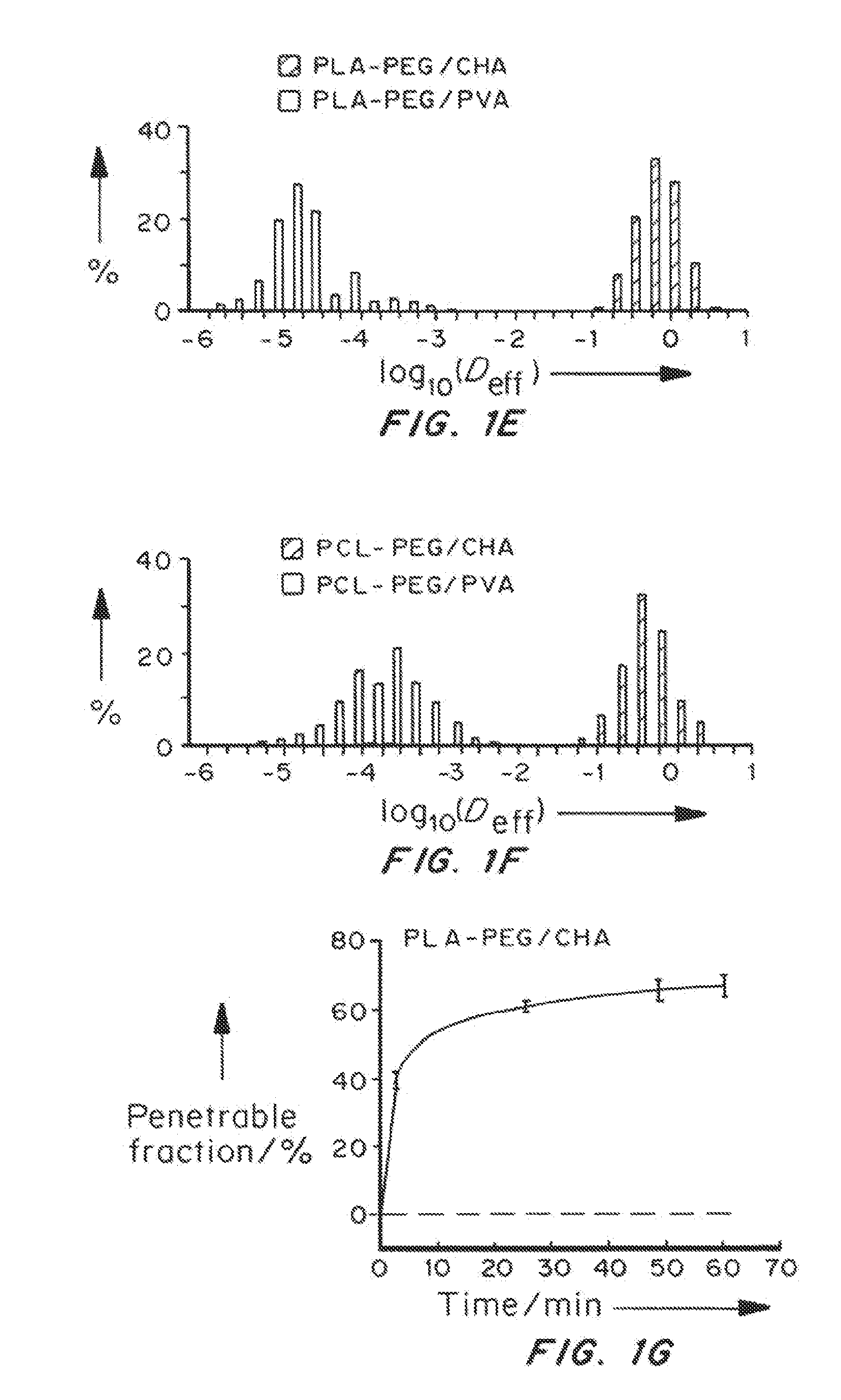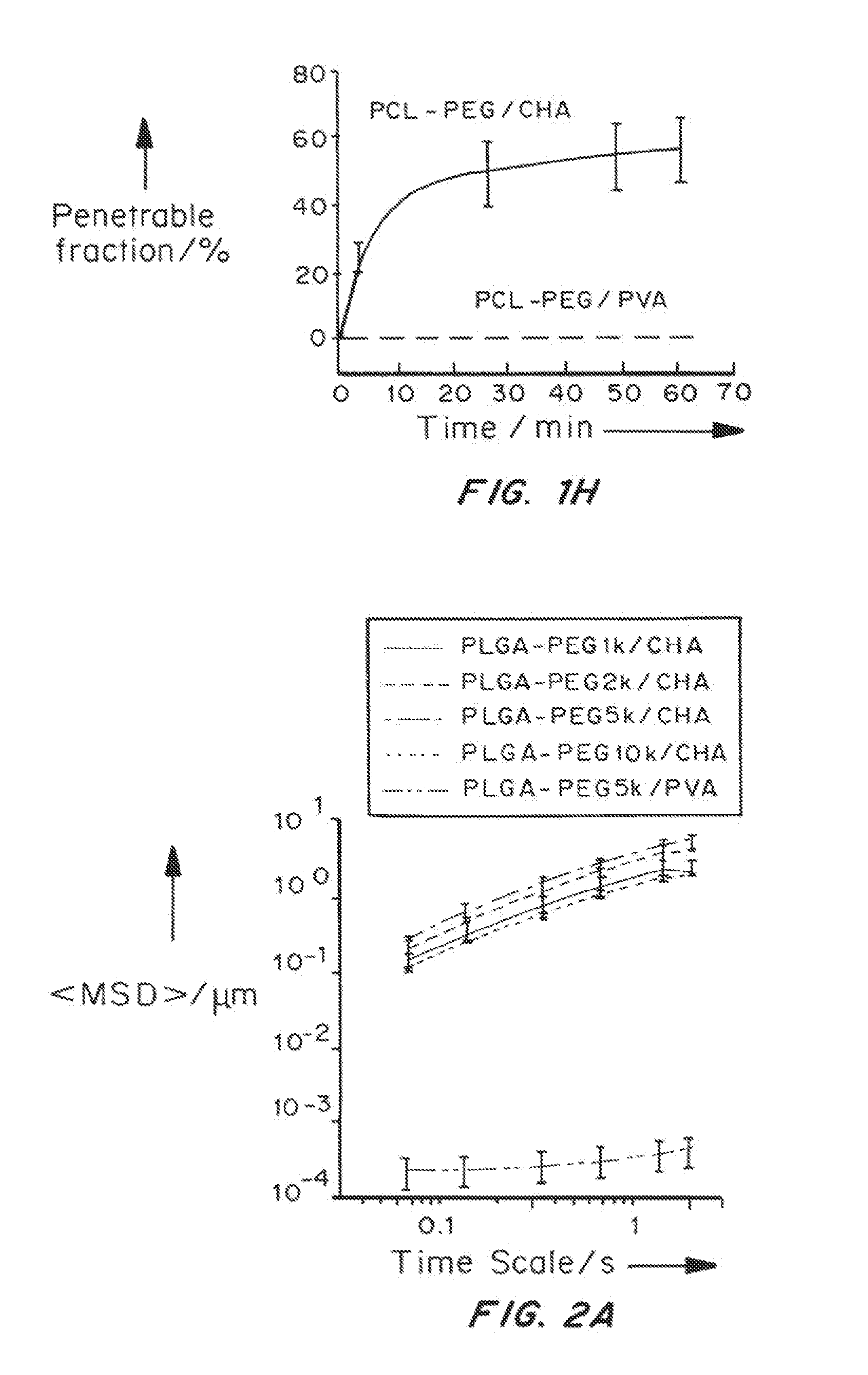Nanoparticle formulations with enhanced mucosal penetration
a technology of nanoparticles and mucosal surface, which is applied in the direction of application, drug composition, biocide, etc., can solve the problems of limited control of drug delivery at mucosal surface, limited efficacy, and large amount of epithelium left susceptible and/or untreated, so as to improve the distribution over a mucosal surface, improve the residence time of mucus-penetrating particles, and improve the effect of diffusion
- Summary
- Abstract
- Description
- Claims
- Application Information
AI Technical Summary
Benefits of technology
Problems solved by technology
Method used
Image
Examples
example 1
Preparation of Nanoparticles
[0188]Materials and Methods
[0189]Biodegradable nanoparticles were prepared by either o / w single emulsion or w / o / w double emulsion method as described in R. C. Mundargi et al, J Control. Release 125, 193 (2008), M. Li et al., Int. J Pharm. 363, 26 (2008), C. E. Astete and C. M. Sabliov, J. Biomater. Sci. Polymer Ed. 17, 247 (2006), and R. A. Jain, Biomaterials, 21, 2475 (2000).
[0190]Nanoparticles were characterized for size, surface property and drug loading (for drug encapsulated nanoparticles). The displacements of nanoparticles were tracked in fresh, undiluted human CVM using multiple particle tracking.
[0191]Nanoparticles Prepared with Different Amounts of PEG
[0192]PLGA-PEG nanoparticles were prepared with varying target PEG contents (0, 2, 3, 5, 8, 10 and 25 wt %, referred to as PLGA, PLGA-PEG2%, PLGA-PEG3%, PLGA-PEG5%, PLGA-PEG8%, PLGA-PEG10% and PLGA-PEG25%) using emulsification. The PEG molecular weight 5 kDa was selected since at the same PEG conte...
example 2
Nanoparticles Prepared with Different Emulsifiers
[0197]Materials and Methods Alexa Fluor 555 cadaverine (AF555) was chemically conjugated to polymers. Nanoparticles were prepared using emulsification. Typically, a mixture (total 50 mg) of PLGA-PEG5k and AF555-labeled PLGA-PEG5k was dissolved in 1 mL dichloromethane (DCM). The oil phase was poured into 5 mL aqueous solution containing 1% emulsifier under sonication (VibraCell, Sonics & Materials Inc., Newtown, Conn.) at 30% amplitude for 2 mins in an ice-water bath to form the oil-in-water emulsion.
[0198]The emulsion was poured into another 40 mL aqueous phase of emulsifier solution under magnetic stirring at 700 rpm for at least 3 hours to allow the solvent to evaporate. The solvent was further evaporated by placing the solution in a vacuum chamber for 30 mins. The final nanoparticle suspensions were filtered through 1 μm syringe filter, centrifuged at 20,000 g for 25 mins and thoroughly washed with water.
[0199]Emulsifiers including...
example 3
Preparation of Drug Encapsulated Nanoparticles
[0205]Materials and Methods
[0206]Curcumin was selected as a model hydrophobic drug which was dissolved with polymer in DCM. The procedure was similar to that for preparation of unloaded nanoparticles. The prepared curcumin-nanoparticles can be visualized in mucus because of curcumin's intrinsic fluorescence.
[0207]BSA was used as a model hydrophilic drug because it is representative of large molecule biologics. BSA-FITC and BSA (10% ratio of BSA-FITC) were dissolved in 0.2 mL 16% w / v aqueous solution at 37° C. This solution was added to 1 mL of 100 mg / ml PLGA-PEG5k in DCM solution during probe sonication (30% amplitude, 1 min with 1 s pulse) in the ice-water bath. The resultant W / O primary emulsion was immediately added to a second water phase (5 mL 1% saponin solution) under sonication (20% amplitude for 2 min). The double emulsion was transferred to another 40 mL 1% saponin solution with magnetic stirring for 3 hours. Nanoparticles were...
PUM
| Property | Measurement | Unit |
|---|---|---|
| osmolality | aaaaa | aaaaa |
| osmolality | aaaaa | aaaaa |
| osmolality | aaaaa | aaaaa |
Abstract
Description
Claims
Application Information
 Login to View More
Login to View More - R&D
- Intellectual Property
- Life Sciences
- Materials
- Tech Scout
- Unparalleled Data Quality
- Higher Quality Content
- 60% Fewer Hallucinations
Browse by: Latest US Patents, China's latest patents, Technical Efficacy Thesaurus, Application Domain, Technology Topic, Popular Technical Reports.
© 2025 PatSnap. All rights reserved.Legal|Privacy policy|Modern Slavery Act Transparency Statement|Sitemap|About US| Contact US: help@patsnap.com



